If you’re searching for a Google keyword position checker, you just found it. Actually, you’ll find multiple keyword rank checker tools on this article.
If you wish to track your current ranks, or are setting up a new project, or need to spy on your competitors’ ranking changes in 2020, you’ll be doing that in the next few minutes.
I intend to get you a complete insight into the setup process, flexible settings and the actual features these keyword position checker tools offer.
And, as always, this list is 100% based on my own experiences, and is completely unbiased and transparent.
Best Google Keyword Position Checker Tools for 2020
Note that you’ll be able to do a lot more than just track keyword positions using these tools. In most cases, these will offer complete SEO solutions.
Anyway, I’ve included the following tools on this list so far:
- SEMrush
- Ahrefs
- SerpWatcher
- Wincher
- SE Ranking
- Moz
Let’s get those keywords tracked then, eh?
1. SEMrush
Website: https://www.semrush.com/
SEMrush is basically the most advanced, feature-rich, accurate SEO tool I’ve ever used. It also boasts of having the most extensive database in the industry.
Its “Position Tracking” tool is what lets me track keywords on Search engines.
Now, two of the biggest benefits I get with SEMrush is that it does track rankings across mobile devices. And, it also offers daily updates. Both of these are free, unlike Ahrefs which charges extra.
As for rank tracking, the setup page first lets me choose a search engine. I can choose either from Google or Baidu.
The same page also lets me choose a device. I can track rankings for desktop, mobile, or even tablet.
And then, I get to choose a location or enter a pin code manually if I’m going for hyper-local tracking.
It then offers creative ways to add keywords to the tracking list. I can obviously add them manually, or, pull organic keywords directly from SEMrush’s “domain report”. In simpler words, it checks my domain (any domain I enter) and shows me the keywords relevant to the domain.
I can even fetch keywords from Google Analytics, or import from a .txt/.csv file.
Anyway, here’s what an overview page looks like on SEMrush:
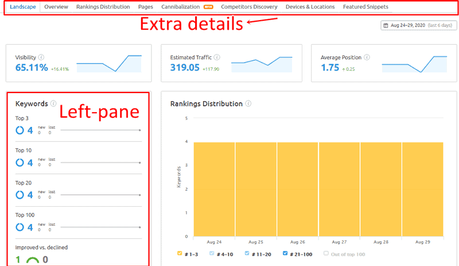
Again, the first shown metric is “visibility”. An overall score for the CTR rate for all my tracked keywords.
Then, estimated traffic from these keywords and the average position for all the tracked keywords is shown.
The box on the left-pane shows me the no. of keywords ranking in the Top 3/ Top 10/ Top 20 and Top 100. It also shows the number of keywords whose position has increased and decreased.
The right-pane just shows me keywords in the top 1-3/ 4-10/11-20/ and 21-100. It’s shown in a chart making it easy to understand.
On the same page, there also is a box for “Top keywords”. It shows the best ranking keywords out of the tracked keywords.
Two other boxes show “Positive Impact” and “Negative Impact”. These show keywords which have gained or lost most visibility.
Next is the “Competitor” insight. It shows me the rankings of my competitors, no. of keywords they’re ranking for (out of all my tracked keywords), visibility and average position.

So, you can use SEMrush as a multiple keyword rank checker tool not just for your domain, but also your competitors’, simultaneously!
There’s also a “SERP features” graph which is shown. Obviously, lets me identify SERP features I’m ranking on.
Then, there’s a table showing me the URLs for my tracked keywords, their avg. position, and estimated traffic they bring to the domain.
Lastly is this unique feature called “Cannibalization”. It lets me see if I have more than one keywords competing for the same keyword on my domain. (You’d be surprised how much help this actually is!)
Note that all of this data is shown just on the “Landscape” page. In the screenshot earlier, I marked the other pages as “Extra Details” if you paid attention.
Well, these extra pages are:
- Ranking distribution: This page displays the rankings for me, and my competitors, in rank-brackets (Top 3, Top 10, Top 20 and so on.) Also shows the new/improved/declined and lost number of keywords for each domain.
- Pages: It displays more in-depth data which includes URLs for each tracked keyword, difference/change in ranking position, estimated traffic, average position, and total search volume for the keyword.
- Featured Snippets: Not only shows my current featured snippets, but also those “opportunities” which I can leverage. Also shows current visibility and traffic, as well as the potential for visibility and traffic if I rank for the shown opportunities.
Other SEMrush features
As mentioned earlier, SEMrush is an extremely feature-rich tool. Some of its superpowers include:
- Keyword rank tracking for paid keywords
- Competition research
- Backlink analysis
- Automated link building workflow
- Content marketing suite
- Social media management
- Paid ad analysis.
- Traffic generation
- Lead generation
- On-page SEO
- Custom, white-labelled SEO reports.
- And, a lot more.
I’ve explained each of those features in my honest SEMrush review. I promise your time won’t be wasted.
SEMrush pricing plans
Why should you trust me saying SEMrush is worth it. That’s right, you shouldn’t, at least not blindly.
You can get a 100% free SEMrush 14 day trial right now. It’s a fully-featured trial and is absolutely free. Go give it a try and see for yourself?
Start SEMrush Free 14-days Pro Trial
After that, the plan is downgraded to SEMrush’s forever free plan. You can use it forever, with limited features.
However, if you wish to upgrade, it offers three plans:
- Pro: $99.95/month: 500 keywords tracked.
- Guru: $199.95/month: 1500 keywords tracked.
- Business: $399.95/month: 5,000 keywords tracked.
My final verdict
SEMrush is what I use most, period. It offers exclusive features that no other SEO tool provides. Even its keyword database is the biggest in the industry at nearly 20 billion keywords!
As far as rank tracking goes, everything that you expect from the best rank tracker tool is offered, and then some.
If you need a “SEO solution”, I’ll say give SEMrush a try, it’s free anyway, nothing to lose eh?
Start SEMrush Free 14-days Pro Trial
2. Ahrefs
Website: https://www.ahrefs.com
Ahrefs is one of the most feature-rich SEO tools. Its “Rank Tracker” feature is what lets you check your keyword rankings.
It offers quite a bit of control when setting up a keyword for tracking.
For starters, it lets me set a frequency for the crawl. It can either be daily/weekly or monthly. For the weekly and monthly choices, I also get to set specific days, dates and even timezones.
It also lets me set a location for the tracking. As for the keywords, I can either enter them manually, or upload via txt/csv files.
What’s impressive is that it auto-suggests some of the top keywords my domain is ranking for. These can be added to my “track list” instantly.
It even shows me my top competitors and lets me add some of those to the tracking list.
Now, this was all the setup process. However, it already tells us how detailed the tool is.
Anyway, here’s the actual keyword overview which is presented for the ranked keywords.

Now, the first metric that’s shown is “visibility”. This is basically the overall CTR for all the tracked keywords.
In simpler words, this is the overall percentage of clicks which I get on my domain, out of all the clicks that my tracked keywords have on a search engine.
Then, it shows me the “average position” for all the tracked keywords.
Next, it shows me the “estimated traffic” I’m getting from these keywords. Now, I personally use it to monitor which keywords have maxed their potentials and which need improvement.
Next is the “SERP features” metric. It shows how many SERP features I rank on, out of all the 10 SERP features that Ahrefs tracks.
And then there’s the “Positions” tab. It just tells me at a glance the number of keywords which gained and lost ranks.
The last tab on this overview bar is that of rank-brackets. It shows the no. of keywords which are ranking in brackets such as 1-3/4-10/11-50/51-100 and 101+.
You may have noticed those numbers in red, in smaller fonts next to each metric. Those show me the “change” in each metric.
When I scroll down (refer to the screenshot below), there’s a table showing me the tracked keywords, their position, traffic from each keyword, difficulty, SERP features the domain is ranking on, and the URL.

This table clearly is detailed, informative and easy to understand. Let me explain the two buttons which may be a bit confusing.
Clicking on the “trend” button (that “graph-line” button, on the left of “SERP” button in the above screenshot) shows the changes in the rankings in a graph.
Clicking on the “SERP” button (in the above screenshot) shows all the other pages ranking for the keyword. A lot of extra information showing traffic, UR/DR/AR, backlinks, RDs etc. is shown for each domain.
On the left on the “Rank Tracker” page, it offers links to “pages”, “grossing” and “metrics” pages.

The “pages” page just shows all the individual pages/URLs which are ranking for any of the tracked keywords.
The “grossing” page is what shows me the rankings for the keywords (and their changes) over longer periods of time. As in, weekly, monthly, 90 days, all time etc.
Finally, the “metrics” page is what offers more data about the keywords in general.
E.g. it shows the difficulty, CPC, volume, no. of clicks (that the keyword gets in total, may or may not be for the tracked domain), return rate, parent topic etc.
See that “Competitors” section on the left-sidebar (in the above screenshot)? Well yes, obviously, it lists the competitors you may have added earlier, and shows their visibility, avg. position, traffic (from all the tracked keywords), SERP feature existence, and the positions.
There’s also a “traffic share” page. It shows the percentage of traffic each of the ranking pages get from search engine.
All in all, that’s a lot of details. Arguably, it’s everything that we expect from any platform claiming to be the best keyword ranking tool.
Ahrefs other features:
Apart from rank tracking, Ahrefs also facilitates:
- Detailed backlink research
- Competition research
- Keyword research
- Site audit
You can read my Ahrefs vs SEMrush comparison for an ultra-detailed into the tool.
Ahrefs Pricing plans
Ahrefs doesn’t offer a free trial. However, you can sign up for its 7-day trial for $7.00.
After that, you can opt for one of the following paid plans:
- Lite: $99.00/month- 500 keywords, updated once a week, no mobile rankings.
- Standard: $179.00/month- 1,500 keyword, updated once in 5 days, no mobile rankings.
- Advanced: $399.00/month- 50,000 keywords, updated once in 3 days, with mobile rankings.
If you need a complete SEO suite, and you’re on a lower budget, and if you need mobile rankings and daily updates for free, you should check the next option on this list.
My final verdict:
Ahrefs does offer one of the most advanced rank tracking features.
But, it charges extra for mobile rankings. Also, these rankings are not updated daily. Daily updates are charged extra as well.
So, I’d say Ahrefs is the best Google keyword position checker tool if you’re on a bigger budget, and if you only need a rank tracker and backlink tool.
Start 7 day Ahrefs trial for $7
3. SerpWatcher by Mangools
Website: https://serpwatcher.com
If you’re just starting out, or, if you need the simplest Google keyword position checker tool, SerpWatcher is for you. (Bonus: It’s super cheap).
It too is one of the few tools which lets me track the mobile rankings as well.
Anyway, the setup is similar to any other tool I’ve used. I get to choose a location, choose a device (desktop/mobile) and enter my keywords.
Again, .txt and .csv files can be uploaded. Or, I can import keywords directly from the KwFinder tool if I added keywords to a list earlier.
Anyway, here’s what a normal tracking page on SerpWatcher looks like:
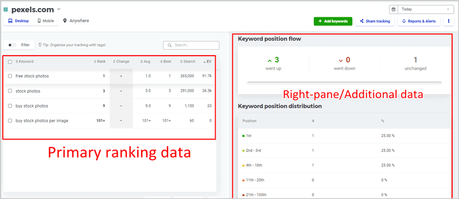
I’ve always and forever been a fan of Mangools’ “one-page interface”. The same is true for SerpWatcher as well. All the data that I need, or is available, is shown on this one page.
Now, it shows the current rankings of the keywords, the change in the rankings, average position of the keyword, best/highest position ever attained, search volume, and the estimated visits (EV) from each keyword and its ranking.
I can just refresh this page daily to track the performance, easy, isn’t it?
However, the right-pane displays additional data.
For starters, there’s a top gainers/losers box showing the keywords which went up or down the most.
It also shows “Estimated visits” I get from the keywords. There’s also a neat graph showing the change in traffic.
Then, there’s a “Keyword position flow” tab. It shows me the number of keywords which went up/down or remain unchanged.
And lastly, just below the position flow, is a SERP-bracket list. It shows me no. of keywords ranking on 1st/ 2nd-3rd/ 4th – 10th positions and so on.
I can click on any of the tracked keywords on the left-pane to get more data about each tracked keyword. Here’s a screenshot:
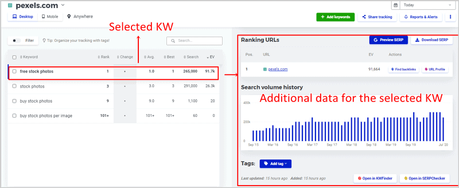
As is clear, it shows me the ranking URL and estimated visits from the keyword. The search volume history is also clearly visible, isn’t it?
What’s not visible (because, the screenshot can’t capture the entire page) is that it also shows me a graph of the keywords position history.
I love its ability to create alerts. I can create alerts for various scenarios. E.g. keyword entering top 10/top 100, or leaving top 10/top 100.
These notifications are sent instantly to my e-mail.
And that’s nearly everything that SerpWatcher offers.
Yes, I agree it’s not as feature-rich as the other best Google keyword position checker tools mentioned above. But, wait till you check the pricing plans.
Other features that Mangools offers
SerpWatcher is just one of the modules that Mangools offers. Equal simplicity is offered on all its other tools.
It offers:
- KWFinder for keyword research
- SERPChecker for SERP analysis
- LinkMiner for backlink research
- And SiteProfiler for on page SEO and overall overview.
You can read my piece on the best Ahrefs alternatives. I’ve discussed all these Mangools modules individually over there.
Mangools pricing plans
You can get a 100% free, all features unlocked trial for 10 days, absolutely free. No cards required. Try Mangools today.
Its paid plans are as follows:
- Basic: $29.90 per month- 200 keywords tracked.
- Premium: $39.90/month- 700 keywords tracked.
- Agency: $79.90/month- 1,500 keywords tracked.
My final verdict
Mangools isn’t as feature-rich as some other options on this list.
But, at the same time, it’s nearly 9x cheaper than the other more advanced keyword rank tracking software out there.
So, I’d say it’s perfect and delivers exactly what it charges for. You wish to track keyword positions and see changes? It delivers.
Also, considering how a lot more can be done with the complete Mangools suite for a single price, I’d say it’s totally worth it.
Start SERPWatcher 10-days Free Trial
4. Wincher
Website: https://www.wincher.com/
I’ll be honest, I only discovered Wincher recently.
However, it proved effective with its rank tracking abilities and hence made it onto this list of the best Google keyword position checker tools.
Wincher too offers both Desktop, as well as mobile rankings.
Here’s a standard dashboard that Wincher shows me for tracked keywords:
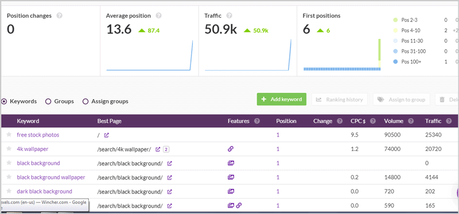
I’m sure you understood everything that it shows, didn’t you? The “Position changes” tab shows me the no. of keywords I gained/lost.
Then there’s the average position tab, traffic, and the no. of keywords in the first position.
Lastly, the overview tab also shows me rank-brackets. So, I can see at a glance the no. of keywords ranking on the different positions/pages on Google.
Below that is just my list of tracked keywords. This table also shows the exact URLs for each tracked keyword, availability/lack of SERP features, position, change, CPC, volume and finally traffic.
I’d say this is enough information as much as pure rank tracking goes. But then, the tool offers more.
It offers various pages showing more detailed information. The most important ones are:
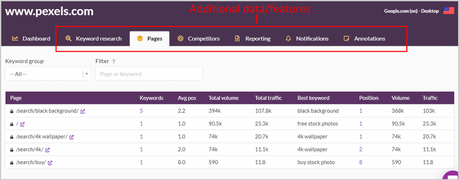
- Pages: Shows the individual URLs which rank for any of my tracked keywords. Even multiple keywords resulting in the ranking of a page are grouped together. Also shows the total search volume, traffic, position etc.
- Competitors: It offers a very detailed, side-by-side comparison of the average position, traffic, position-changes for each of your competitors. Words aren’t enough so here’s a screenshot which will explain things better:
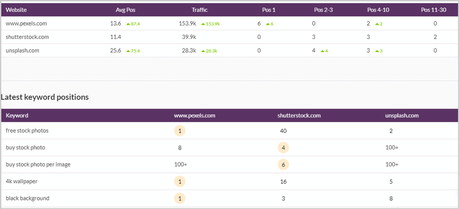
- Keyword research: A very basic keyword research feature. Does show CPC, traffic, volume, competition and ranking position for a bunch of keywords.
And, that’s about it as far as Wincher goes.
Other features that Wincher offers
Now, this one is exclusively a “rank tracker tool”. However, it does facilitate basic keyword research.
Competition research too is offered even though it’s integrated with the primary Google keyword position checker module. It does offer impressive insights as discussed above.
It also generates reports in a single click. These can be previewed as well as downloaded.
Wincher pricing plans
Wincher offers a very generous 14-day, “no card required” trial plan.
After that, it offers dynamic pricing. Meaning, you pay according to the number of websites and keywords you’re tracking.
The lowest, in my experience is EUR 10.00/month, for 1 website and up to 100 keywords.
The price increases automatically (EUR 3.00/month) as you add 1 website + 100 keywords.
My final verdict
It’s basically for anyone who needs a Google keyword position checker tool that’s easy to use, and offers flexible plans.
Given its daily update+ mobile ranking features, I’d say it’s priced rationally. Give it a try, eh? It’s free.
Start Wincher 14-days Free Trial
5. SE Ranking
Website: https://seranking.com/
SE Ranking’s initial launch itself was marketed as it being one of the best rank tracking software. However, today it’s a complete SEO suite and offers nearly everything that there is to SEO.
It lets me track my rankings on Google, Yandex, Yahoo, Bing and even Youtube! Now, that’s impressive.
Keywords can be imported from Google Analytics, CSV/XLS files, or, entered manually.
Now, the interface is pretty unique. Well, here’s how it looks:
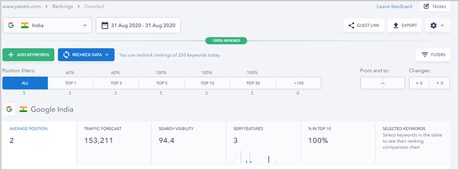
So, there’s the position filter. It lets me filter the keywords on the page based on their positions. Available options include Top 1/ Top 3/ Top 5/ Top 10 and so on.
This lets me easily find the keywords that I wish to work on avoiding those which are either already ranking, or too far behind.
Or, I can enter a “from” and “to” position filter manually and specifically. Next to that is a tab showing the number of keywords which went up, or, came down.
Below that is an overview tab. It shows the avg. position for all my tracked keywords. Then, it shows me a “traffic forecast”. It’s basically similar to the “estimated traffic” that most other tools show.
The “Search visibility” is the % of clicks your keywords get, out of all the clicks for the tracked keywords.
SERP-feature rankings are displayed as well. And lastly, it shows me the % of my tracked keywords in top 10.
At the bottom of this page is a list of the tracked keywords, their URLS, SERP-features they’re ranking on (if available) and the position.
There’s another feature called “Ranking changes”. I can enter any domain and it instantly generates a detailed report showing the ranking changes for it.
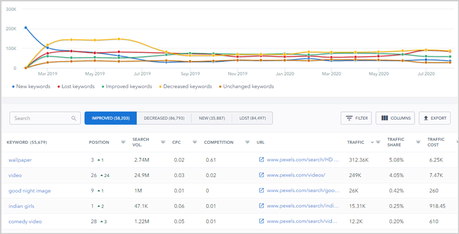
This being “instant” lets me get data when I’m in a hurry. As is evident, the line graph shows new/lost keywords as well as decreased/improved/ and unchanged keywords.
The keyword list is extremely detailed. It shows me the current positions, changes in the positions, CPC, and even paid competition along with total traffic, traffic share and traffic cost for each keyword.
There’s this unique feature which lets me share a link to any page on SE Rankings with anyone. They don’t need to signup. I don’t need to generate a “report”. Just sharing this link lets them access the report.
And that’s about it as far as SE Ranking goes as a Google keyword position checker. However, it offers a lot more.
Other features that SE Ranking offers
I did mention earlier, it’s a complete SEO tool. It offers the following tools/features in addition to being a rank tracker:
- Keyword research
- Backlink Research
- Advanced competition research
- On page SEO optimization
- Paid ad insights etc.
SE Ranking pricing plans
SE Ranking too offers a 14 day trial period. After which you can opt for its paid plans.
It offers very dynamic pricing packages. They primarily depend on two factors. The first being your “update frequency”. You can choose from daily/ every 3 days / weekly.
The second factor influencing your pricing plans is your subscription period. The longer you subscribe for, the bigger your discount will be.
The cheapest plan can be purchased for $18.6/month (weekly update frequency, paid annually.)
Apart from this, you can build your own package depending on those two factors.
My verdict
SE Ranking is extremely feature-rich, easy to use, and does deliver pretty accurate rank tracking data.
Even when searching for an overall SEO suite, it wouldn’t disappoint. Multiple search engines and report-sharing links are my favorite features.
However, the fact that it charges extra for daily update hurts. All in all, it’s worth a try considering how it’s free for 14 days anyway.
Start SE Ranking 14-days Free Trial
6. Moz
Website: https://moz.com/
Everyone in the SEO business has heard of Moz, haven’t you? It’s one of the most successful, established and feature-rich SEO suits.
For starters, it lets me track ranks on Google, Bing, and Yahoo. And, it does include mobile rankings (for Google.)
This is the overview tab for tracked keywords.

As is traditional, the first metric is “visibility”. It’s a percentage-score of the amount of clicks my tracked keywords receives, out of all the clicks for those searches.
Then a simple rank-bracket section shows how many of my keywords are on which positions.
The “Movement” tab shows the up and down movement of the keywords.
And finally the featured snippets shows the number of keywords ranking on featured snippets.
Below the overview is where the really interesting things are found. Here’s what’s shown:
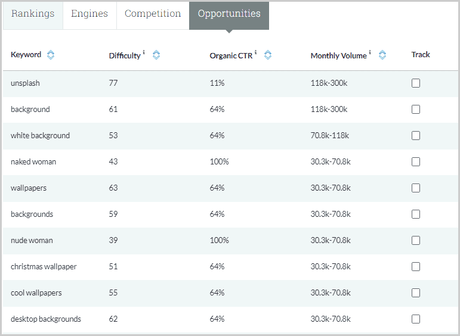
Let me explain the tabs quickly?
- Rankings: It shows a simple graph showing the rankings for each week (or month, depending on your settings)
- Engines: You can select if you wish to check desktop/mobile or algorithm-update rankings (this is when a new Google algorithm is pushed.)
- Competitors: Obviously, shows my and my competitors’ rankings on a table for all the tracked keywords.
- Opportunities: It shows keywords I’m not ranking for currently, but I should target because they’re relevant.
And that’s an overview of what makes Moz one of the competitors for the top spot in this best Google keyword position checker race.
Other features that Moz offers
Moz obviously offers a lot more than just “rank tracking” which includes:
- Keyword research
- Backlink research
- Limited competition research
- On page SEO
- And Backlink analysis.
Moz pricing plans
Moz offers a 30 day trial, however, it requires credit cards. The paid plans are as follows:
- Standard: $99.00/month
- Medium: $149.00/month
- Large: $249.00/month
- And Premium: $599.00/month.
My verdict
My biggest problem with Moz is that it doesn’t offer daily ranking updates.
Apart from that, I still use various metrics from Moz on a daily basis. Especially its DA/PA metrics for domains.
However, if I’m being honest, it’s not “the” best Google keyword position checker. Sure, if weekly rankings are what you need, it totally gets back in the game and competes for the top spot.
Final verdict on the best Google keyword position checker tool
Those are quite a few options, aren’t they? And, most of them are equally feature-rich.
So, which is the best keyword rank tracker then?
SEMrush. It has the biggest database (by numbers), offers mobile+ daily rankings, but most importantly, includes a ton of exclusive SEO tools.
After SEMrush though, Ahrefs totally deserves the second spot. Or, you can go with Mangools if you need “simplicity”.
Although, most of the tools on this list offer a free trial. So, feel free to go with any one of them.
Do remember that there’s no single best Google keyword position checker tool, it depends on a dozen factors, including your budget, requirement, goals and business-model. And hey, mind hitting that share button? Help your friends & colleagues track their rank eh?
